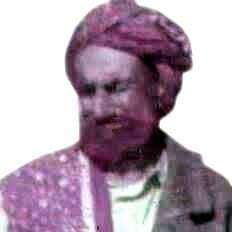
RADIANT POETRY OF THE LUMINOUS POET OF KOHISTAN BAGH MUHAMMAD ‘BESHAK’ JOKHIO
By: Jasarat Ilyas Jokhio
Malmari- a fertile valley of the Southern Sindh has been very famous in the literature and history of Sindh as many of the staunch writers have recognized it as an ancient and historical valley of Sindh, located in the wide and vast hugs of the fertile Karo Jabal near Jungshahi Kohistan 7/4, Taluka and District Thatta where we can find a variety of folklore figures whose poetry is like a candle in the darkness. Bagh Muhammad ‘Beshak’Jokhio is also one of those poets and folklore stars of the last century whose poetry is considered as the most authentic source of loving the nature and motherland in this ancient village, full of the traditional treasures of Sindhi language famous “Kohistani” accent spoken here since centuries.
It was the post-partition decade of 1950 when Master Abdul Aziz Jokhio- the leading writer of Malmari published the biography of Bagh Muhammad Jokhio for the first time in the history of Sindh in the monthly magazine “Nain Zindagi” of Sindhi language which became the base of the introduction of this luminous star of Kohistan in the history of Sindhi language and literature. Later on, famous educationist Dr. Nabi Bux Khan Baloch also visited Karo Jabal and the surrounding areas to collect folklore historical information. In the late 1980s, it was another successful attempt by Prof. Amanullah Jokhio who wrote about him in an Urdu language newspaper and Sindhi language magazine “Paigham”. In the 1990s one of the grandchildren of Bagh Muhammad Beshak started writing and working on him was Bisharat Ilyas Jokhio who published the biographies of his maternal grandfather in various newspapers like Daily Hilal Pakistan Karachi, Daily Jago, Monthly Gull Phull, and a few other magazines of Sindhi language. In the English language, no one wrote about him until 2011 when I translated a few of his poetic lines into English and posted them on a popular social media website Facebook. The author also published a detailed biography on Bagh Muhammad “Beshak” Jokhio on November 23, 2020, in the English daily newspaper Daily Parliament Times, Islamabad.

Formally Bagh Muhammad Beshak Jokhio was not much literate but he looks as knowledgeable as he has mentioned names of the various types of utensils, tools, jewelry, weapons, household stuff, and traditional tools used for animal keeping in his poetry. As per my research along with his grandchild Mr. Khashal Khan, there are 27 types of jewelry which he has discussed elegantly in his poetry with exemplary comparison; such as Nath, Boulo, Dussari, Wariyaro, Kheerol, Cherry, Kiyotiyoon, Alpaak, Nabssi, Daandari, Noora, Durr Mooriyon, etc. The mentioned jewelry is a tool of ornamental attraction in this rich customs region. Historians have witnessed about his formal education that he was just three grades of a primary pass from an old Government Primary School Jati (the then a Taluka in district Thatta which is now a Taluka in district Sujawal) Sindh, which shows his qualitative intelligence. In spite of not being much literate, he has also discussed many psychological issues, complicated situations, problems of life, and possible solutions which even a highly qualified man can state and handle hardly. Folklore is that, which contains all experiences of life and its discussion through such veteran poets.

Camels have been used as a source of livelihood and food security for centuries in the Kohistan of Sindh and Balochistan. Bagh Muhammad Beshak Jokhio was also one of the famous Camel-lovers. He used to travel on Camel from Malmari to visit Jungshahi and Makli on a frequent basis on rent as there were no motor cars or scooters available in this backward area in those days. He visited Kathor and Malir for shopping purposes as well. Wherever he went for his business and social circumstances, he used Camels as a source of traveling. Even soon after the partition of India, once he left Malmari to visit Kutch Gujrat (Indian border territory) on Camel from Malmari Kohistan which extends a distance of more than 700 KM (through Jati, Sindh). He used to meet folklore poets, historians and saw the incidence of partition with his eyes. During this journey, he appraised Adam Kutchi (the traditional salty fish and Tea maker in Jati Sindh) in his poetry;
Wow!Adam Kutchi Kutchi!
So spicy is your fish!
Additionally, Kohistan of Thatta has various historical icons and archeological places such as; the famous Karo Jabal, Murr Muqam (a graveyard), Malmari, Jungshahi, Jhimpir, and the areas starting from Dhabeji extending up towards the east. Bagh Muhammad traveled across the region for different purposes. Some of the tasks which his elder daughter Sher Khatoon and second son Abdul Hannan Jokhio told me that he used to explore the eternal and inner-spiritual satisfaction by visiting many shrines, monasteries, and graveyards wherefrom he obtained spiritual light by loving Sufi saints like as; Jungshahi, Mian Syed Ali Shah Sheerazi, Shah Murad Sheerazi, Shah Pariyoon, Makhdoom Muhammad Hashim Thattvi, Dars Waryo, Makhdoom Adam and many of the other Soofi shrines located at Makli and nearby areas. Moreover, in this consequence, he had also visited Multan and Sehwan for visiting the tombs of Bahauddin Zakariya Multani and Lal Shahbaz Qalandar whom he considered as his Murshids (spiritual mentors).
There are various researchers who have been working on his personality and poetic creations starting from Abdul Aziz Jokhio (the staunch first writer of Malmari) to Jan Muhammad Janbaz and various other names come in the list but yet his poetry compendium needs to be published which he named “Kullyat-e-Bagh” (the faculty of Bagh). The unpublished poetry is saved with his grandchildren who will publish it soon (hope so) so that such a luminous poet’s work may come forth for the inspiration of new generations ahead.
Bagh Muhammad “Beshak” left this immortal world on February 26, 1984, at the age of 75 years. He was buried at the historical monument of Jungshahi where his grave is present for his lovers.

